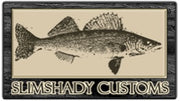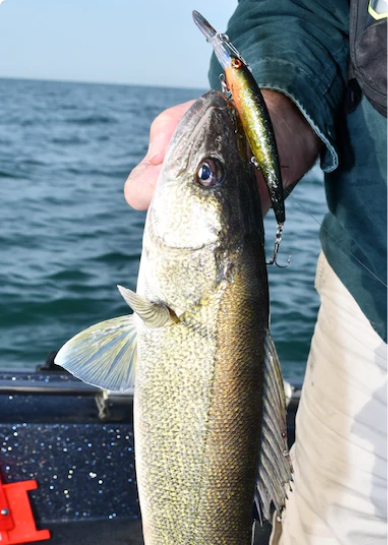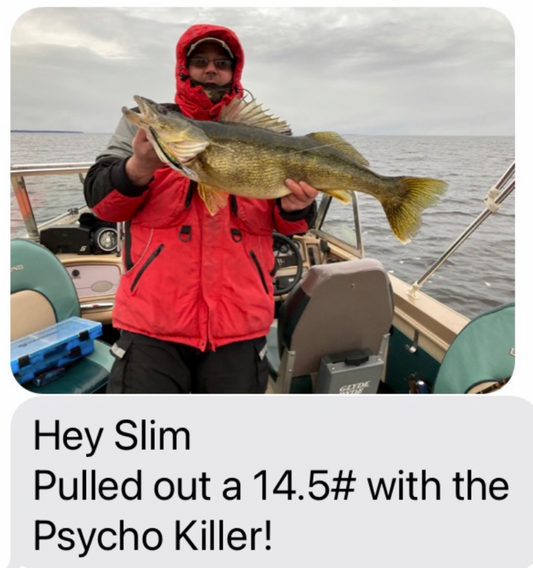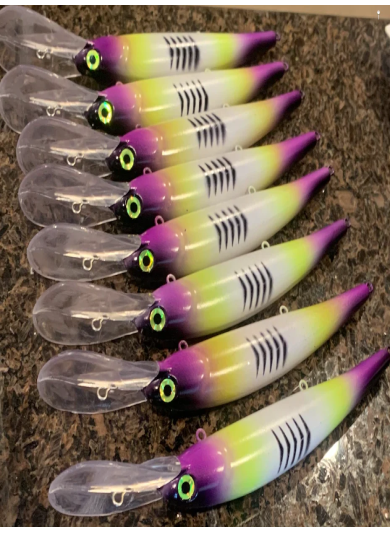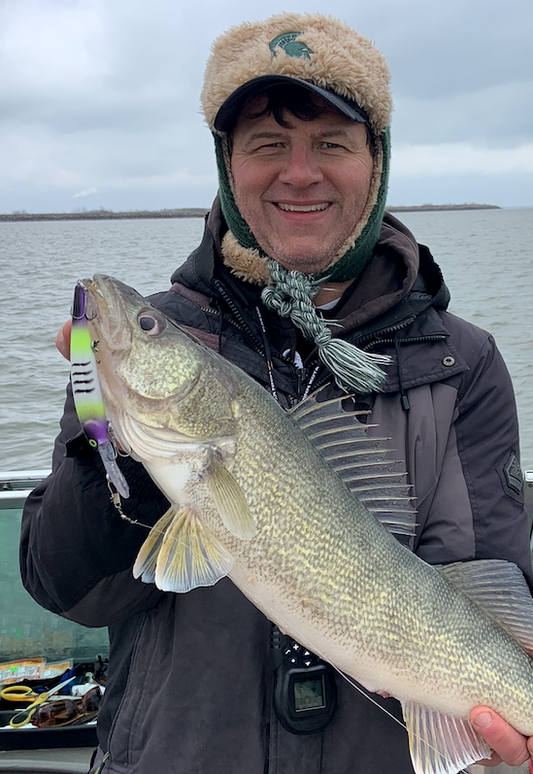How deep is my crankbait running?
When trolling with crankbaits, it is critical to know how deep they are running. This is especially true around the great lakes, where walleyes typically suspend off the bottom and generally feed upward in the water column.
Back in the mid 80's, when we first started trolling with crankbaits on Lake Erie, it was very difficult to know how deep your baits were running. First of all, we didn't have line counters, only regular spinning gear. Secondly, we didn't have any dive charts for the Wiggle Warts or Hot-N-Tots that we were using. Therefore, the only way we could figure out deep they were running was to go into shallower water and then keep letting out line until we could feel them bumping bottom. In order to get a consistent presentation, we would back-reel the baits out (instead of just casting them), and then count the number of "turns-back". We would start with maybe 35-40 turns-back and then keep letting out line 5-10 turns at a time, until we started catching fish.
Nowadays, we are very lucky, as we have amazing technology that we can leverage to create a precise, repeatable program for trolling. We have planer boards, 2D Sonar, side-imaging sonar, real-time forward facing sonar, rod-trees, etc, etc.
Precision Trolling App:
But there is another tool in the arsenal that every troller should have, IMO. That is the Precision Trolling App. Mark Romanack and his team have spent many countless hours gathering dive-curve data for hundreds of different crankbaits. Various brands, models, sizes, etc. The app is free, but you will have to buy the dive-curve data. The good news is, they allow you to buy them by the bait for around $3 each. So, if you limit the number of brands and models that you use, you won't need to break the bank getting the data. They also sell them in various bundled packages.
The app is available on the Apple App Store or Google Play. (Precision Trolling App).
This is a screenshot of the mobile app:

The app is very simple and well designed. They give you one dive curve for free with the app, but that only helps if you plan on running that particular lure.
To get the dive curve for my baits (or Bandits), you will need to download the correct dive-curve. Once you have the app installed on your device, you will need to go into their store and search for the following dive curve:
"Bandit Deep Walleye 5/8 oz"
Once you find that, you will need to purchase it and download it into your device. You only have to do this the first time and from then on it will be in your app.
The next step is to select that lure and you will see a screen similar to the one I pasted above. At the top, you will see "Line Type (Click to Change)". Immediately below that you will see "10# Berkley XT". That is the default line-type used for the dive-curve data. The other options for this particular lure are "10# Berkley Fireline" and "50+ 2oz snap-weights". There are other options for other lures, but I will not be covering those in this article.
This does not mean that you must run 10# Berkley XT or Fireline to use the app, however, it does mean that in order to have the most accurate data, you need to run line that has a similar diameter and characteristics as that line type. Berkley XT is a monofilament, which floats. The same diameter flouro-carbon based line will sink, which can alter the results. However, IMO, it is more important to duplicate your set-ups after you catch a fish than it is to be 100% accurate from the beginning. Therefore, I don't worry about that too much.
There is a huge difference, however, between 10# mono and 10# braid, which is why they offer dive-curves for both. I will cover snap-weights later in this article.
If you are running 10# mono, then leave the line-type setting as-is, and turn your focus to the two dials below them. You can either pick a depth and see how far back you need to be in order to get that depth, or you can do it the opposite way and start with "Feet back".
For those who are new to trolling with boards, "feet-back" refers to the amount of line between the bait and your in-line planer board (or to the release if you are using big-boards). It could also be the distance between the bait and a stern planer, if you are running those.
Snap-Weights:
In MI waters of Lake Erie or Lake St. Clair, we are generally fishing water less than 30 feet deep and fishing our baits anywhere from 5-20 feet down most of the time, therefore, the baits can easily reach those depths on their own. However, when the water warms and the fish move east into deeper water, we may pull out the snap-weights for added depth.
As I mentioned earlier, there is a setting in the app under "line-type" for using the "50+2 oz" snap-weight system. What this means is that you let out 50 feet of line, attach a 2 oz snap-weight (www.offshoretackle.com) and then add additional line to the desired depth.
In the app, you would need to change the line-type setting to "50+2 oz", from there, move the left dial to the depth that you would like to reach with your baits. For example, let's say you would like to get down to 25 feet. The right dial will then move to 74 feet, which means that you let out 50 feet of line, attach a 2oz snap-weight and then let out another 24 feet of line before attaching your board. How far you let the board out away from the boat is not relevant to the depth the bait is running. However, the speed that you are pulling your baits is relevant with snap-weights. Therefore, the app allows you to select speeds from 1.5 to 2.5 mph, which will affect the measurements.
Snap Weight Depth Chart:
While the data in the precision trolling app is awesome and extremely helpful, it is limited to the 50+ method. It also doesn't account for really slow trolling speeds that we often use during the cold water periods. For example, this winter, we were able to catch walleyes from the boat in every month. To do so, we were typically trolling anywhere from .8 to 1.2 mph most of the time.
I also prefer to vary the distance from lure to the weight to match the distance from the weight to the board. This is simply my personal preference.
Therefore, I decided to create a handy chart that I store in my phone, which makes it easy to know how deep I am with various settings.
Here are some definitions to help you understand the chart:
Lure to Weight (LTW): You set your line-counter to zero, put the lure in the water and let it out to this distance.
Weight to Board (WTB): After you put the weight on, you let it out this distance further and then attach the board.
The number at the intersection of those two distances is the depth that the lure will be running. The speed adjustments on the right side are for speeds other than 1.5 mph. For example, if you are going 1.5 mph using a Bandit (or one of my baits), and you want to get down to 25 feet, you could do any of the following set-ups:
LTW: 50 / WTB: 25
LTW: 40 / WTB: 30
LTW: 30 / WTB: 35
If you are trolling slower or faster than 1.5, then you would need to use the adjustments on the right to account for this.
Lastly, you also need to be aware of underwater currents that may impact your speed measurements. For example, we were recently trolling on Erie relatively close to the Detroit River on a flat-calm day. Going S to N we were going 1.0 mph with my Ultrex set on 6. From experience, I know that I should be going closer to 1.5 at that setting on a flat day. Out of curiosity, I made a turn and started trolling N to S and our speed went up to 1.8 - 1.9 mph without making any changes to the trolling motor. The difference in speeds was .8-.9 mph, so that tells me that the current was about .4 - .45 mph from N to S.
In that situation, if we are trolling around 1 mph into the current, I would use the dive curve info for 1.5 mph, because that is the actual speed of the baits relative to the water.

The chart has data for medium diving baits (Smithwick Perfect 10 Rogue, for example), as well as shallow divers (Rapala Husky Jerks, for example).
Feel free to save the chart to your phone and use it on the water.
Note: I do not guarantee that the data is 100% accurate, as I have extrapolated the measurements based on all of the known data that is available to me. I am not a rocket scientist, but I am a degreed engineer, and I believe that it should get you close enough. It has worked very well for me, which is what really counts, IMO.
What about running baits straight back (without boards)?
If you are running baits straight back behind the boat, then the calculation gets a bit complicated. Here's why:
- If your rod is in a rod holder (or in your hands), then there will be a section of line that is out of the water.
- The higher your rod tip is from the water, the longer that distance will be.
- The app will tell you the correct distance needed from the point where the line enters the water, to the bait.
- If your rod tip is way up in the air, then you might have 40-60 feet of line that is out of the water, which would need to be added on top of the recommended distance to get to the desired depth.
- For example, let's say that you want your lure to reach 10 feet deep. The dive-curve shows that distance to be 35 feet back. With your rod in the rod-holder, you estimate that you have about 20 feet of line from the rod-tip to the water, so your total amount of line showing on the line counter reel would be 55.
- As a side note, if you are pulling cranks straight behind the boat and the water gets shallower all of a sudden, just grab the rod and get the rod tip as high as possible and that will bring the bait up in the water column.
